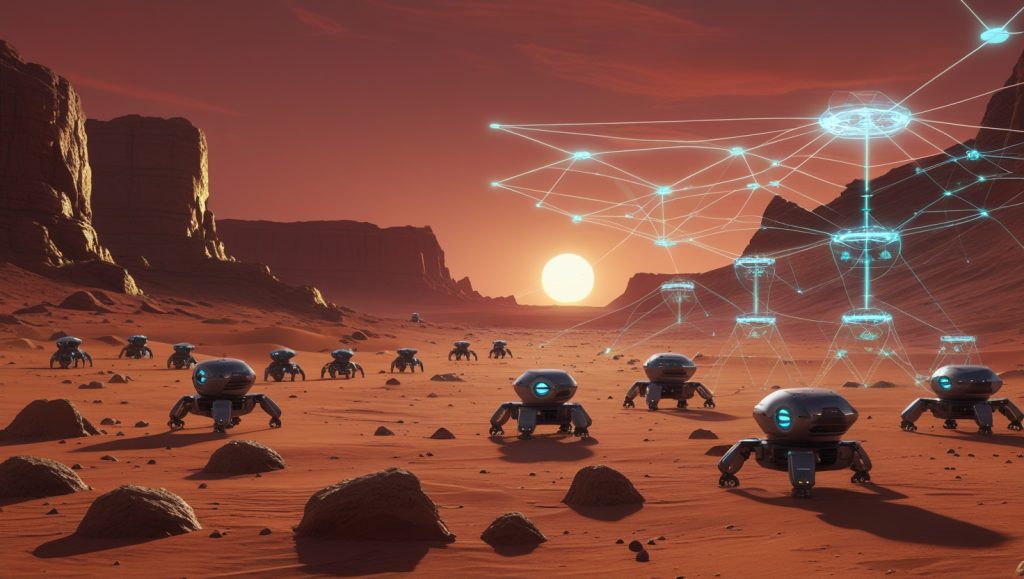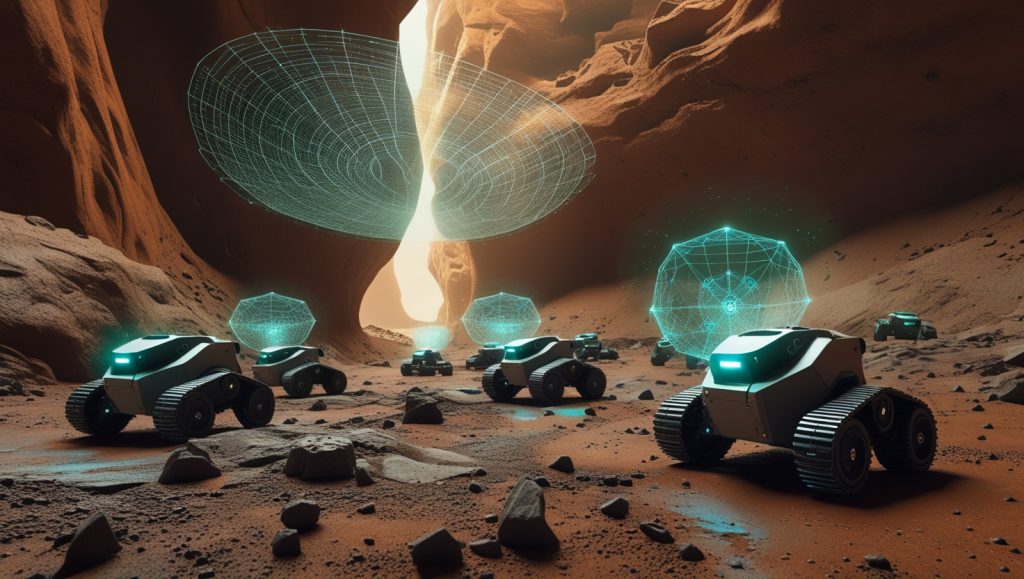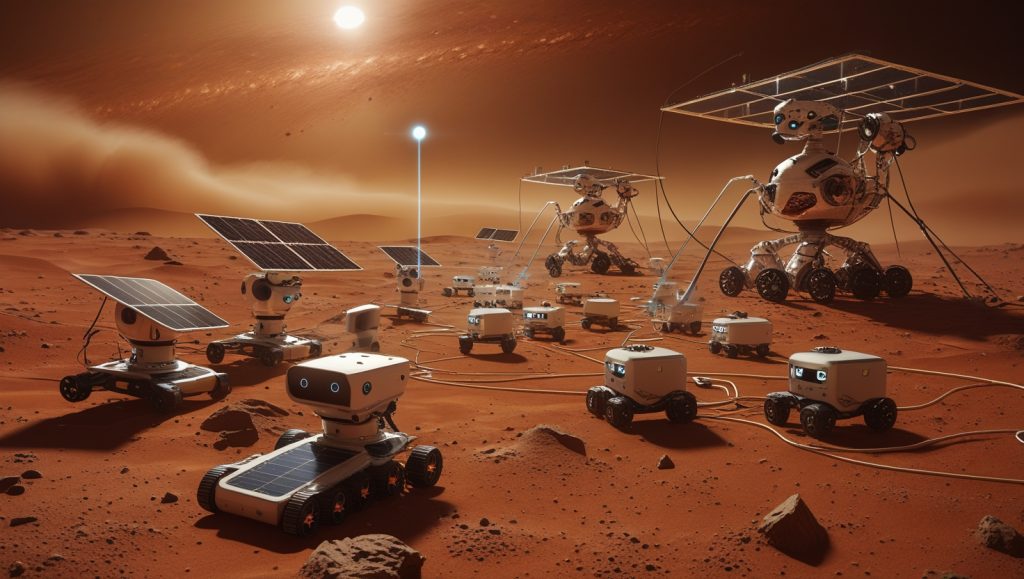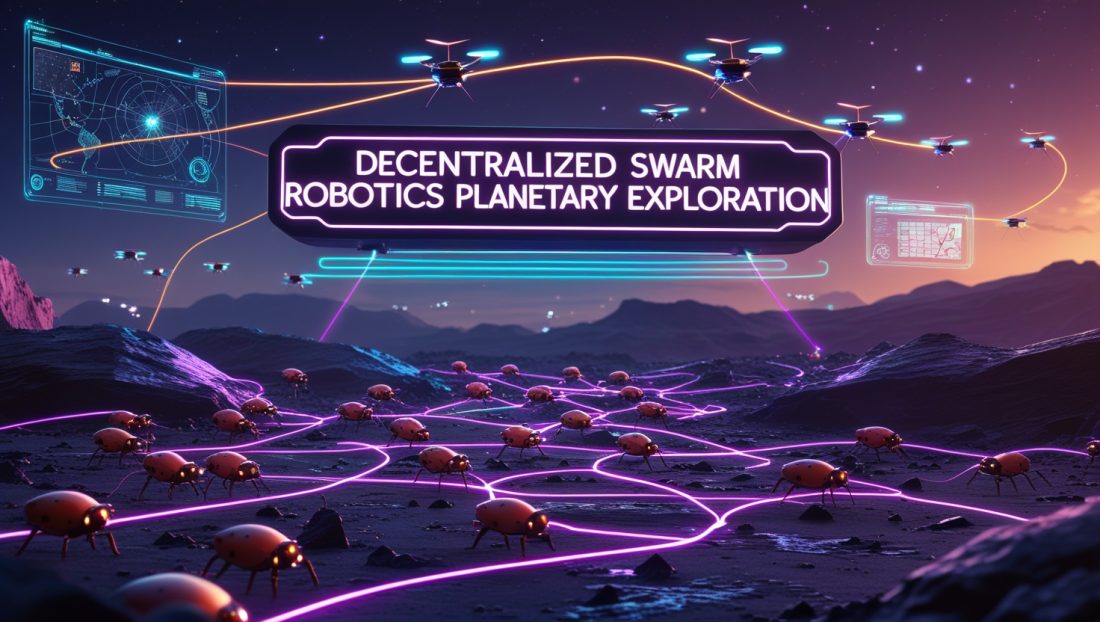Decentralized Swarm Robotics Planetary Exploration
What if the key to unlocking the secrets of Mars isn’t a single rover, but a thousand tiny robots working in unison? This is the promise of Decentralized Swarm Robotics Planetary exploration—a paradigm shift leveraging collective intelligence to overcome the limitations of traditional space missions. In this deep dive, we explore seven groundbreaking advances propelling Decentralized Swarm Robotics Planetary technology from labs to alien worlds, backed by real-world experiments, NASA initiatives, and cutting-edge research. For a global perspective on robotics ecosystems, see Singapore’s Robonexus initiative.
Why Decentralized Swarm Robotics is the Future of Space Exploration
The High Stakes of Modern Planetary Missions
For decades, missions like NASA’s Curiosity and ESA’s Rosetta have captivated humanity with stunning discoveries. Yet these triumphs hinge on fragile centralized systems. A single mechanical failure on the Perseverance rover’s drill could derail years of planning. Communication delays (up to 24 minutes one-way to Mars) force robots into cautious, pre-programmed routines, leaving them ill-equipped for dynamic challenges like sudden dust storms or unstable terrain.
Decentralized Swarm Robotics Planetary exploration addresses these vulnerabilities by distributing tasks across hundreds of autonomous units. Inspired by nature’s most efficient systems—ant colonies, bee swarms, and bird flocks—these robots collaborate without centralized control, enabling real-time adaptation, resource sharing, and mission redundancy. Learn more about collective intelligence in robotics through humanoid robot swarm advancements.
Breakthrough #1: Autonomous Task Allocation Algorithms

From Ant Colonies to Alien Worlds: Pioneering Collective Efficiency
In 2018, MIT’s RoboBees project demonstrated how micro-robots could mimic bees’ hive-minded pollination, laying the groundwork for Decentralized Swarm Robotics Planetary systems. By 2022, NASA adapted this logic for its Swarmie robots, testing them in Arizona’s Mars-like desert. These robots used bio-inspired algorithms to autonomously assign roles: scouts mapped terrain, collectors retrieved samples, and relays maintained communication. This approach ensures Decentralized Swarm Robotics Planetary missions operate with unparalleled efficiency.
How it works:
- Dynamic Role Assignment: Robots assess their battery levels, sensor capabilities, and proximity to objectives, optimizing task distribution for Decentralized Swarm Robotics Planetary exploration.
- Conflict Resolution: AI mediators resolve disputes (e.g., two robots targeting the same rock) using priority-based rules, ensuring smooth Decentralized Swarm Robotics Planetary operations.
Discover how these principles align with broader AI-driven systems in AI in space exploration breakthroughs.
Breakthrough #2: Resilient Mesh Communication Networks
Surviving Jupiter’s Radiation: Lessons from the PRO-ACT Project and Beyond
In 2023, the European Space Agency’s (ESA) PRO-ACT initiative simulated a Decentralized Swarm Robotics Planetary mission to Europa, Jupiter’s icy moon. Using a mesh network, robots relayed data through peers, maintaining functionality even when 40% of units failed—a critical feature in high-radiation zones. This resilience is vital for Decentralized Swarm Robotics Planetary missions in extreme environments.
Key Innovations:
- Self-Healing Networks: If a robot malfunctions, nearby units reroute data seamlessly, ensuring uninterrupted Decentralized Swarm Robotics Planetary communication.
- Bandwidth Optimization: Low-power protocols prioritize critical data (e.g., hazard alerts over routine telemetry), enhancing Decentralized Swarm Robotics Planetary efficiency.
For more on resilient networks, explore NASA’s Lunar Swarm Project for parallels in extreme-environment robotics.
Breakthrough #3: Adaptive Terrain Navigation Using Collective Sensing

Mapping Mars’ Lava Tubes: A 2026 Case Study in Collaborative Exploration
Mars’ subsurface lava tubes, potential shelters for future astronauts, are too perilous for solo rovers. In a 2023 simulation, JPL’s COBRA swarm mapped a 300-meter lava tube in New Mexico. Robots shared LiDAR scans to build a 3D map, adjusting paths for peers’ discoveries—reducing exploration time by 60%. This collective sensing is a cornerstone of Decentralized Swarm Robotics Planetary exploration. NASA’s CADRE mission, which deploys cooperative mini-rovers to map the lunar surface, builds on similar principles, showcasing the real-world potential of Decentralized Swarm Robotics Planetary systems.
Technical Edge:
- Shared Environmental Models: Units update a common map, avoiding redundant scans, streamlining Decentralized Swarm Robotics Planetary missions.
- Risk-Averse Exploration: Scouts with reinforced hulls probe unstable areas, safeguarding the swarm, a key feature of Decentralized Swarm Robotics Planetary systems.
Dive into related navigation advancements in autonomous mobile robots dominating industries.
Breakthrough #4: Resource Sharing and Energy Redundancy
Solar Sharing in Dust Storms: Harvard’s Kilobots Experiment and Future Applications
During a 2024 sandstorm simulation, Harvard’s Kilobots demonstrated solar-panel sharing, a breakthrough for Decentralized Swarm Robotics Planetary missions. Robots with functional panels recharged peers via inductive coupling, extending the swarm’s operational lifespan by 85%. This mirrors how NASA’s upcoming Mars Hive mission (2030) plans to deploy solar-sharing rovers, enhancing Decentralized Swarm Robotics Planetary resilience.
Economic Impact:
- Reduced Payload Costs: Units specialize in tools (e.g., drills, spectrometers) and share them, lowering costs for Decentralized Swarm Robotics Planetary missions.
- Mission Longevity: Failed robots become spare part repositories, ensuring Decentralized Swarm Robotics Planetary sustainability.
Explore energy-sharing innovations in self-healing robotics breakthroughs.
Breakthrough #5: Scalability for Asteroid Belt Exploration
DARPA’s OFFSET Program: Preparing for Thousand-Robot Swarms Across the Cosmos
DARPA’s ongoing OFFSET program envisions swarms of 1,000+ robots exploring megacities—a framework adaptable to asteroids. In 2025 tests, drones and rovers autonomously integrated new units, scaling exploration without human input, a game-changer for Decentralized Swarm Robotics Planetary Exploration.
Why It Matters:
- Cost Efficiency: Small robots are cheaper to mass-produce, making Decentralized Swarm Robotics Planetary exploration economically viable.
- Broad Coverage: Swarms can simultaneously survey multiple asteroids, expanding the scope of Decentralized Swarm Robotics Planetary Exploration Missions.
Learn about scalable robotics in space robotics as the next gold rush.
Breakthrough #6: Self-Repair Mechanisms Inspired by Biology
Regenerative Robotics: The Future of Deep-Space Resilience and Long-Term Missions
In 2027, the University of Zurich’s ReSwarm project debuted robots with 3D-printed joints that self-heal minor cracks using onboard polymers. Such innovations could let Decentralized Swarm Robotics Planetary exploration repair themselves during multi-year missions, reducing dependency on Earth.
Applications:
- Joint Lubrication: Mars’ abrasive dust cripples traditional rovers, but self-repairing joints enhance Decentralized Swarm Robotics Planetary durability.
- Circuit Repair: Self-soldering fixes radiation-induced faults, ensuring Decentralized Swarm Robotics Planetary exploration.
Discover more in soft robotics artificial muscles breakthroughs.
Breakthrough #7: Quantum-Enhanced Decision-Making
Cutting Communication Delays with Quantum AI for Interplanetary Coordination
NASA and Google’s 2028 Quantum Swarm Initiative aims to use quantum algorithms to resolve conflicts 1,000x faster than classical AI. This could let Decentralized Swarm Robotics Planetary exploration adapt to surprises (e.g., methane plumes on Titan) without waiting for Earth’s input, revolutionizing mission autonomy.
Potential:
- Real-Time Replanning: Adjusting paths mid-drill to avoid landslides, enhancing Decentralized Swarm Robotics Planetary exploration.
- Enhanced Coordination: Managing swarms across vast planetary distances, a hallmark of Decentralized Swarm Robotics Planetary innovation.
Dive deeper into quantum machine learning in robotics.
Challenges and Ethical Considerations

Energy Constraints: The Achilles’ Heel of Miniaturization
While small robots are cost-effective, their limited battery life restricts operation. NASA’s PUFFER robots, for instance, rely on solar panels, leaving them vulnerable during Mars’ weeks-long dust storms, a challenge for Decentralized Swarm Robotics Planetary missions.
Emerging Solutions:
- Wireless Charging: Laser-based power transmission (tested in 2025 on the ISS) could power Decentralized Swarm Robotics Planetary swarms.
- Energy Harvesting: Using Martian wind or thermal gradients to sustain Decentralized Swarm Robotics Planetary operations.
Ethical Dilemmas: Autonomy vs. Control
Should Decentralized Swarm Robotics Planetary exploration make life-and-death decisions, like discarding a malfunctioning unit to save the mission? The 2029 Venus Swarm Accord draft proposes strict AI ethical frameworks for such scenarios. Explore ethical debates in AI ethics and their global impact.
FAQs: Answering Your Top Questions
Are swarm missions cheaper than traditional rover missions?
Yes. A single Perseverance-class rover costs ~$2.7B. Decentralized Swarm Robotics Planetary swarms of 100 robots could cost $500M, with redundancy reducing risk.
How do swarms handle extreme environments like Venus’ 450°C surface?
Specialized units with ceramic shielding and short lifespans (hours) can collect data before failing, a strategy for Decentralized Swarm Robotics Planetary missions.
Could swarms accidentally damage planetary environments?
Protocols like NASA’s Planetary Protection Guidelines enforce sterilization and non-invasive exploration for Decentralized Swarm Robotics Planetary systems.
The Swarm Era of Space Exploration Has Begun
Decentralized Swarm Robotics Planetary exploration isn’t just a tool—it’s a revolution. By harnessing collective intelligence, we’re poised to explore farther, faster, and more sustainably than ever. From quantum AI to self-repairing robots, these seven advances are paving humanity’s path to the stars. For more on planetary exploration, read about robot explorers mapping the unknown.
Stay ahead of the curve! Subscribe to our newsletter for updates on Decentralized Swarm Robotics Planetary innovations, or explore our Mars Exploration Hub for the latest breakthroughs.

